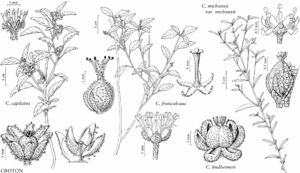Croton capitatus
Fl. Bor.-Amer. 2: 214. 1803.
Herbs, annual, 3–8 dm, monoecious. Stems well branched distally, stellate-hairy, hairs whitish to pale-yellow, glabrescent. Leaves not clustered; stipules filiform, 2–5 mm; petiole 0.5–6 cm, glands absent at apex; blade ovate to lanceolate-elliptic, 3–8 (–15) × 1–4 cm, base rounded to cuneate, margins entire, apex obtuse to acute or rounded, abaxial surface light green, not appearing brown-dotted, no stellate hairs with brown centers, adaxial surface darker green, both appressed stellate-hairy. Inflorescences bisexual, racemes or capitate, 1.5–3 cm, staminate flowers 5–15, pistillate flowers 3–6. Pedicels: staminate 0.5–1.5 mm, pistillate 0–1.5 mm. Staminate flowers: sepals 5, 0.8–1 mm, abaxial surface stellate-hairy; petals 5, linear-oblong-lanceolate, 0.8–1 mm, abaxial surface stellate-hairy; stamens 7–12. Pistillate flowers: sepals 6–9, equal, 7–10 mm to 15 mm in fruit, opening broadly and persistent after capsule dehiscence, margins entire, apex recurved, abaxial surface stellate-hairy; petals 0; ovary 3-locular; styles 3, 2–3 mm, 2–3 times 2-fid, terminal segments 12–18 (–24). Capsules 7–9 × 5–6 mm, smooth; columella tipped with 3-pronged grappling hooklike appendage. Seeds 5 × 4.5–5 mm, shiny. 2n = 20.
Phenology: Flowering Jun–Oct.
Habitat: Pastures, old fields, cultivated land, prairies, floodplains, longleaf pinelands, sandy to loamy soils.
Elevation: 0–300 m.
Distribution

Ala., Ark., Del., D.C., Ill., Ind., Iowa, Kans., Ky., Md., Mass., Miss., Mo., Nebr., N.J., N.C., Ohio, Okla., Pa., S.C., Tenn., Tex., Va., W.Va.
Discussion
Croton capitatus is frequently confused with C. heptalon and C. lindheimeri. Croton capitatus usually has some leaves that are blunt-tipped and mucronate (versus all or most acute in C. lindheimeri), and the pistillate sepals are longer than the ovary, with tips that flare outward at anthesis. Also, C. capitatus has petioles roughly equal in length from the middle to the tip of the stem, whereas C. lindheimeri has petioles that decrease more markedly in length from the middle to the tip of the stem. Occurrences of C. capitatus east of the Appalachian Mountains are likely adventive.
Selected References
None.
Lower Taxa
"connate" is not a number. "distinct" is not a number.
